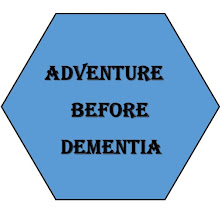The balloon arrived about the same time we did, all folded up on a trailer. The crew unloaded it and inflated the balloon by filling it with air from a big fan, followed by heating the air with the onboard gas burners.
As the balloon began to rise, we were hustled on board to serve as ballast, lest the whole thing float away. There were 17 people on board, sorted into four compartments with the pilot in the middle. The ground crew were ready to follow us across the countryside to wherever we landed.
The pilot controlled the height of the balloon with four gas burners, more heat - more height. Otherwise, we were at the mercy of the wind, which sent us gently gliding over the countryside.
The terrain was mostly flat - seemingly endless miles of red dirt, low shrubs and a few trees. Looking straight down really accentuates the red colors at dawn. We were flying over a couple of cattle ranches, but we didn't spot any cows - or any kangaroos. Just emptiness - and totally quiet (when the burners weren't blasting away).
We could see another balloon ahead of us - it looked just like ours - a nice silhouette against the early morning sky.
Our pilot landed us smoothly in a little clearing - as he turned off the burners, it didn't take long for the balloon to collapse behind us.
And then - standing around wasn't an option - the crew recruited everyone to help with squeezing the air out of the balloon, rolling it up, and cramming it into a big canvas bag. When it was all done, we loaded back on our bus for a glass of outback champagne (water) and the ride back to town. We were back at the hotel by 7:00 AM, just in time for breakfast.
The Aborigines people were all over Australia (and Tasmania); today there are still over 500 tribes, with members belonging to smaller groups called clans. Each clan had its own distinct body of sacred sites and the area surrounding these forms the clan's land. These groups are linked by common traditions, intermarriage, and shared language. Each group has a totem that provides a tangible expression of their link to the dreamtime ancestral beings. Within and between groups, ceremonies and rituals are held, stories are told, pictures are drawn, and daily life is defined.
The history of the Aboriginal people is complex, starting with the dream time, the time of creation. Their world is inhabited by ancestral beings whose activities were of some significance in history and which has a living presence today. These beings and their stories may be represented by a rock, a sand hill, a grove of trees, a cave - for the Aborigines, the creative essence remains forever within the physical form. Dreamtime was in the past, but it is the Aborigines present religion and culture. The saying, "As it was done in the Dreamtime, so it must be done today," dominates all aspects of behavior.
Theirs is not a world that blends well with the white European world of the 21st century. The present-day picture is not a pretty one - it's a tale of poverty, welfare, unemployment, lack of education, diseases (especially diabetes and kidney disease), alcohol abuse, gas-sniffing, domestic and child abuse, and mostly ... boredom. Their land has been taken, their culture is largely destroyed - only 20 years ago some of the people were hunter-gatherers living in the outback. Adjustment to the white man's civilization has been not very successful.

At Jessie Gap, we saw the only white sand known in this part of the country. The sand is believed to be the fat of the emu - a large flightless bird that lives in these parts.
Another stop was Emily Gap, where we could see kangaroo tracks around a waterhole and rock paintings on a cliff wall.
We went into Amoongauna Aboriginal Community, a totally depressing place not usually visited by tourists. We were able to go there because Lindsay has relatives living here. This place is home to about 300 people, a mixture of skin groups unaccustomed to living together - Lindsay says this causes lots of problems, but the white man's government refuses to understand.
He took us to the Amoonguna Arts Center, where several women from the community were painting and many beautiful pictures were available for purchase. Lindsay brewed up a bit of billy tea and gave us some damper (outback bread), the traditional food and drink of Outback adventurers.
After meeting the principal and offering our small gifts of school supplies, we set off for the 5-6 grade class to read with the students. They were waiting for us - Fran was paired with a girl named Nakita and Margaret with a boy named Roland. They were very shy and soft spoken, and as they read to us, it was clear that they are far behind expectations for this grade level. As the principal pointed out, most of them live in crowded conditions where they have no room or even bed of their own, no books in the house, and no adults to take the time to read to them. They seemed to enjoy our time together, but we wished we could do something to improve their long-term outlook.





















